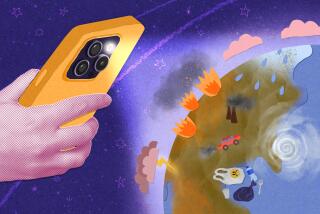Youngsters Ready Their Messages for Earth Orbit : SpaceArc: Thoughts of Encinitas schoolchildren will be included with thousands of others in a time capsule scheduled for launch in 1992.
- Share via
The message 9-year-old Caitlin Schmidt of Encinitas wants hurled into space is a cry for world peace.
“Dear anyone,” her letter begins. “I have a dream of peace. I don’t know if it will ever come true, but if you find this and you know a way to stop war, even if you think it’s foolish, please tell someone or tell a newspaper or find some way to let people know that WAR IS SELFISH!”
Michael Torres’ missive for future generations is a hand-drawn memorial picture of teacher-astronaut Sharon (Christa) McAuliffe who was killed in 1986 during a launch of the space shuttle Challenger.
And 9-year-old Ryan Katkov penned a present-day description of modern art for posterity’s sake because, as any kid knows, the art of the next millennium is all going to be created by computers.
Call it the ultimate in air mail, a collective snapshot of the year 1990 rocket-launched into the next century and beyond. It’s pictures, questions and pieces of advice straight from Earth’s citizens of today to those of tomorrow--to be sent into space aboard a tiny, Earth-orbiting satellite.
And, if all goes well, the words and images of about 125 North County schoolchildren will be among millions of personal messages scanned onto optical discs that will soon become part of the space-bound time capsule.
The students, classmates at the Rhoades School for exceptional children in Encinitas, are among the first pupils in the nation to take part in the SpaceArc project, which will send about 6 million messages from around the world into space aboard a craft the size of a large basketball.
Scheduled for launch in the fall of 1992 to commemorate International Space year and the 500th anniversary of Christopher Columbus’ discovery of the New World, the time capsule will circle the Earth at a distance of 22,500 miles for, presumably, a future generation to retrieve as a chronicle of life on Earth during the early 1990s, according to project originators.
“Maybe they’ll decide to bring it down to celebrate the 1,000th anniversary of Columbus’ discovery, who knows?” said James Ferren, director of the project organized by the Rochester Museum & Science Center in Rochester, N.Y., and a consortium of organizations including NASA’s Educational Affairs Division and Ford Aerospace.
Ferren said President Bush will soon take part in a major campaign to ensure that people of all ages “from every country in the world” participate in the project. Initially, entry forms are being sent to schools around the world.
Ferren said the idea for SpaceArc came while writing a high school English paper 17 years ago. “The assignment was to design a cultural event that would bring the world together,” he said.
“It was very idealistic, have everyone on Earth write a page of a book and then send the book into space. Amazingly, instead of dying in high school, the idea is finally going to be put into practice as a time capsule in space.”
For $2.50 per message, participants can fill a 7-inch by 7-inch space with comments about war or peace, family and friends as well as the environment or their goals and dreams--all, it is hoped, to be launched aboard a shuttle craft, Ferren said.
“Actually, you can fill the space with whatever you want to pass on to future generations,” he said. “We’ve had some amazing results. One 11-year-old from Kiev wrote a violin piece. And we had another 11-year-old from Buffalo write a companion piece to go with that.”
The satellite, Ferren said, will also include instructions on how to retrieve the messages, as well as a multi-language dictionary and encyclopedia.
Luanne Kittle, assistant director of the Rhoades School, said a teacher on the staff heard about the project from a Rochester teacher and got the school involved.
As part of lectures given during Space Week, teachers at Rhoades School circulated entry forms to students in kindergarten through the eighth grade and instructed them to get their parents involved in their responses, she said.
The results, she said, show that even the youngest students see space as a potential job site of the future. “For them, it’s not so much a magical world. They’re not scared. They see it in a realistic way, as a place where many of them will be working in the future.”
“The project has got them thinking about the future, asking questions and getting in touch with the values they want to communicate to future generations.”
Nasahn Reader, for example, wanted to know if there would be any religion left when the next century rolled around. Twelve-year-old Miki Batchman wrote a poem entitled “Forever.”
“How much is infinity?” she asks. “More than the grains of sand on a beach/More than the molecules in vast oceans/More than the places man can reach.”
Christine Hinkle’s message for space was a little more troubled--a poem in the shape of an expanding circle examining war and pollution on Earth.
Her sentiments for her children’s children?
“It’s that a lot of people tried to help the Earth back in 1990,” she said, “but they didn’t get too far.”
More to Read
Sign up for Essential California
The most important California stories and recommendations in your inbox every morning.
You may occasionally receive promotional content from the Los Angeles Times.














